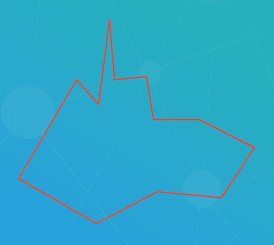Product:
AnnotationManager
Annotation Types
Customize
Polygon Annotations
Polygon annotations are annotations users can draw with multiple points. This can be used to draw any closed shape with lines around content. When initialized, polygons start with no points so they will have to be manually added. The last point in a polygon annotation's path must be the same as the first point to close it out.
Polygon annotations can have both a fill and stroke color. The stroke or border style can also be changed to between a solid, dashed, or cloudy style. The cloud polygon is actually just a polygon annotation with the cloudy style.

While creating the polygon create tool, double-clicking will automatically close the path.
Instantiation
XFDF
Element name: polygon
sh
Required properties
PageNumber
Gets or sets the page number of a document that the annotation appears on.
Notable properties
For the full list of properties, please visit the annotation's API docs.
ArcDrawMode
Describes how the arcs of a PolygonCloud annotation will be drawn, can be one of either RANDOM_ARCS or EQUAL_ARCS.
This property can be set using the ArcDrawModes constant on the PolygonCloudCreateTool. e.g. Tools.PolygonCloudCreateTool.ArcDrawModes.EQUAL_ARCS
StrokeColor
Gets or sets the color of the annotation's stroke.
FillColor
Gets or sets the color of the annotation's interior.
Style
Gets or sets the border style of an annotation. Possible styles include:
- solid
- dash
- cloudy
StrokeThickness
Gets or sets the width of the annotation's stroke outline.
Dashes
Gets or sets the border dash style of an annotation. This expects a string representing the length of dashes and spacing inbetween, delimited by commas (ex. 3, 3). You can specify any amount of lengths but, an odd number of values will be made even by cloning it as a second set. To understand further, you can read more about the setLineDash API.
Intensity
Describes intensity of cloudy style effect. Use 0 for no effect.
Author
The author of the annotation.
Color
Gets or sets the annotation's stroke color.
Hidden
Gets or sets whether the annotation is hidden.
Invisible
Gets or sets whether the annotation is invisible, only if it is an unknown annotation type. Generally for hiding annotations you should use "Hidden".
IsClickableOutsideRect
Gets or sets whether any parts of the annotation drawn outside of the rect are clickable.
Listable
Gets or sets whether the annotation should be listed in annotation lists. If set to false, the annotation will also become unselectable.
Locked
Gets or sets whether the annotation is locked or not. If it's locked it can't be edited or deleted, but the note can be edited.
LockedContents
Gets or sets whether the annotation contents are locked or not. If the contents are locked then note can't be edited but the annotation can be edited or deleted.
NoDelete
Gets or sets if this annotation can be deleted.
NoMove
Gets or sets whether or not the annotation can be moved.
NoResize
Gets or sets if this annotation can be resized by the user.
NoRotate
Gets or sets if this annotation can be rotated.
NoView
Gets or sets whether the annotation is visible on the screen. Differs from Hidden in that it can still be printed if the print flag is set.
NoZoom
Gets or sets if this annotation scales with the page.
Printable
Gets or sets whether the annotation should be displayed when printing the page.
ReadOnly
Gets or sets whether the annotation is readonly or not. If it's readonly both the annotation itself and its note can't be edited or deleted.
ToggleNoView
Gets or sets whether the ToggleNoView flag is set on the annotation.
Useful methods
addPathPoint
When initializing the polygon annotation, you should use the addPathPoint API to add points the annotation path. The last point should be the same as the first to close out the path.
getPath
To read the path or points of the polygon annotation, you can use getPath to get an array of points.
getPathPoint
If you know which point of the annotation path you would like to get, you can use getPathPoint with the point index to retrieve the point.
setPathPoint
Setting the path points on the polygon annotation can be done through setPathPoint. This can be used to initialize the points of the annotation if that was not done at the start.
Did you find this helpful?
Trial setup questions?
Ask experts on DiscordNeed other help?
Contact SupportPricing or product questions?
Contact Sales